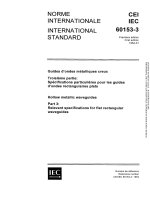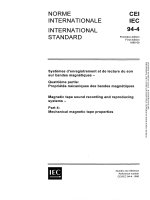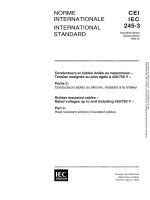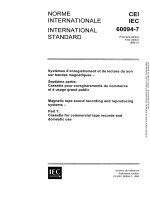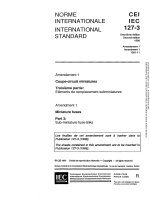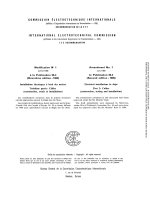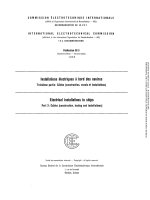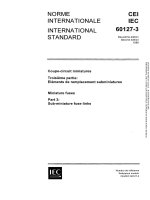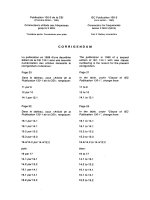Iec 60748 3 1986 scan
Bạn đang xem bản rút gọn của tài liệu. Xem và tải ngay bản đầy đủ của tài liệu tại đây (7.49 MB, 262 trang )
NORME
INTERNATIONALE
INTERNATIONAL
STANDARD
CEI
IEC
60748-3
Première édition
First edition
1986-01
LICENSED TO MECON Limited. - RANCHI/BANGALORE
FOR INTERNAL USE AT THIS LOCATION ONLY, SUPPLIED BY BOOK SUPPLY BUREAU.
Dispositifs à semiconducteurs
Circuits intégrés
Troisième partie:
Circuits intégrés analogiques
Semiconductor devices
Integrated circuits
Part 3:
Analogue integrated circuits
IEC•
Numéro de référence
Reference number
CEI/IEC 60748-3: 1986
Numbering
De p uis le 1er janvier 1997, les publications de la CEI
sont numérotées à partir de 60000.
As from 1 January 1997 all IEC publications are
issued with a designation in the 60000 series.
Publications consolidées
Consolidated publications
Les versions consolidées de certaines publications de
la CEI incorporant les amendements sont disponibles.
Par exemple, les numéros d'édition 1.0, 1.1 et 1.2
indiquent respectivement la publication de base, la
publication de base incorporant l'amendement 1, et la
publication de base incorporant les amendements 1
et 2.
Consolidated versions of some IEC publications
including amendments are available. For example,
edition numbers 1.0, 1.1 and 1.2 refer, respectively, to
the base publication, the base publication incorporating amendment 1 and the base publication
incorporating amendments 1 and 2.
Validité de la présente publication
Validity of this publication
Le contenu technique des publications de la CEI est
constamment revu par la CEI afin qu'il reflète l'état
actuel de la technique.
The technical content of IEC publications is kept
under constant review by the IEC, thus ensuring that
the content reflects current technology.
Des renseignements relatifs à la date de reconfirmation de la publication sont disponibles dans le
Catalogue de la CEI.
Information relating to the date of the reconfirmation
of the publication is available in the IEC catalogue.
Les renseignements relatifs à. des questions à l'étude et
des travaux en c-s urs entrepris par le comité technique
qui a établi cette publication, ainsi que la liste des
publications établies, se trouvent dans les documents cidessous:
Information on the subjects under consideration and
work in progress undertaken by the technical
committee which has prepared this publication, as well
as the list of publications issued, is to be found at the
following IEC sources:
ã
ôSite web» de la CEI*
•
IEC web site*
•
Catalogue des publications de la CEI
Publié annuellement et mis à jour
régulièrement
(Catalogue en ligne)*
•
Catalogue of IEC publications
Published yearly with regular updates
•
Butietin de la CEI
Disponible à la fois au ôsite webằ de la CEI*
et comme pộriodique imprimộ
ã
(On-line catalogue)*
IEC Bulletin
Available both at the IEC web site* and
as a printed periodical
Terminologie, symboles graphiques
et littéraux
Terminology, graphical and letter
symbols
En ce qui concerne la terminologie générale, le lecteur
se reportera à la CEI 60050: Vocabulaire Électrotechnique International (VEI).
For general terminology, readers are referred to
IEC 60050: International Electrotechnical Vocabulary
(IEV).
Pour les symboles graphiques, les symboles littéraux
et les signes d' 'sage général approuvés par la CEI, le
lecteur consùlterL la CEI 60027: Symboles littéraux à
utiliser en électrotechnique, la CEI 60417: Symboles
graphiques utilisables sur le matériel. Index, relevé et
compilation des feuilles individuelles, et la CEI 60617:
Symboles graphiques pour schémas.
For graphical symbols, and letter symbols and signs
approved by the IEC for general use, readers are
referred to publications IEC 60027: Letter symbols to
be used in electrical technology, IEC 60417: Graphical
symbols for use on equipment. Index, survey and
compilation of the single sheets and IEC 60617:
Graphical symbols for diagrams.
* Voir adresse «site web» sur la page de titre.
* See web site address on title page.
LICENSED TO MECON Limited. - RANCHI/BANGALORE
FOR INTERNAL USE AT THIS LOCATION ONLY, SUPPLIED BY BOOK SUPPLY BUREAU.
Numéros des publications
NORME
INTERNATIONALE
INTERNATIONAL
STANDARD
CEI
IEC
60748-3
Première édition
First edition
1986-01
LICENSED TO MECON Limited. - RANCHI/BANGALORE
FOR INTERNAL USE AT THIS LOCATION ONLY, SUPPLIED BY BOOK SUPPLY BUREAU.
Dispositifs à semiconducteurs
Circuits intégrés
Troisième partie:
Circuits intégrés analogiques
Semiconductor devices
Integrated circuits
Part 3:
Analogue integrated circuits
© IEC 1986 Droits de reproduction réservés — Copyright - all rights reserved
Aucune partie de cette publication ne peut être reproduite ni
utilisée sous quelque forme que ce soit et par aucun
procédé, électronique ou mécanique, y compris la photocopie et les microfilms, sans l'accord écrit de l'éditeur.
No part of this publication may be reproduced or utilized in
any form or by any means, electronic or mechanical,
including photocopying and microfilm, without permission in
writing from the publisher.
International Electrotechnical Commission
3, rue de Varembé Geneva, Switzerland
Telefax: +41 22 919 0300
e-mail:
IEC web site http: //www.iec.ch
IEC
•
Commission Electrotechnique Internationale
International Electrotechnical Commission
McHSayHaponHaR 311eKTpOTeXHN4eCHaq HOMHCCHA
CODE PRIX
PRICE CODE
XF
/^
Pour prix, voir catalogue en vigueur
For price, see current catalogue
-
2 -
748-3 © CET 1986
SOMMAIRE
Pages
10
PRÉAMBULE
PRÉFACE
10
Index des références croisées
12
CHAPITRE L GÉNÉRALITÉS
Articles
I. Note d'introduction
2. But
14
14
1. Termes généraux
2. Termes relatifs aux valeurs limites et aux caractéristiques
2.1 Amplificateurs linéaires
2.2 Régulateurs de tension et de courant
2.3 Circuits interrupteurs de signaux analogiques (à l'étude)
3. Symboles littéraux
3.1 Amplificateurs
3.2 Régulateurs de tension et de courant
3.3 Circuits interrupteurs de signaux analogiques (à l'étude)
16
16
16
26
32
32
32
34
36
CHAPITRE III: VALEURS LIMITES ET CARACTÉRISTIQUES ESSENTIELLES
SECTION UN — FEUILLE CADRE POUR LA PRÉSENTATION DES DONNÉES PUBLIÉES
I.
2.
3.
4.
5.
6.
7.
Fonction
Description du circuit
Valeurs limites
Conditions de fonctionnement recommandées
Caractéristiques électriques
Caractéristiques mécaniques et autres données
Données d'application
40
40
40
42
42
44
44
SECTION DEUS — AMPLIFICATEURS OPÉRATIONNELS (_A DEUX ENTRÉES ET UNE SORTIE)
I.
2.
3.
4.
5.
6.
7.
Fonction
Description du circuit
Valeurs limites
Conditions de fonctionnement recommandées
Caractéristiques électriques
Caractéristiques mécaniques et autres données
Données d'application
44
44
46
48
50
58
60
SECTION TROIS — AMPLIFICATEURS AUDIOFRÉQUENCES, AMPLIFICATEURS VIDÉOFRÉQUENCES
ET AMPLIFICATEURS MULTICANAUX POUR TÉLÉCOMMUNICATIONS
1.
2.
3.
4.
5.
6.
7.
Fonction
Description du circuit
Valeurs limites
Conditions de fonctionnement recommandées
Caractéristiques électriques
Caractéristiques mécaniques et autres données
Données d'application
60
60
62
64
64
74
74
LICENSED TO MECON Limited. - RANCHI/BANGALORE
FOR INTERNAL USE AT THIS LOCATION ONLY, SUPPLIED BY BOOK SUPPLY BUREAU.
CHAPITRE II: TERMINOLOGIE ET SYMBOLES LITTÉRAUX
748-3 © I E C 1986
- 3
CONTENTS
Page
FOREWORD
11
PREFACE
Cross references index
11
13
CHAPTER I: GENERAL
Clause
I. Introductory note
2. Purpose
15
15
1. General terms
2. Terms related to ratings and characteristics
2.1 Linear amplifiers
2.2 Voltage and current regulators
2.3 Analogue signal switching circuits (under consideration)
3. Letter symbols
3.1 Amplifiers
3.2 Voltage and current regulators
3.3 Analogue signal switching circuits (under consideration)
17
17
17
27
33
33
33
35
37
CHAPTER III: ESSENTIAL RATINGS AND CHARACTERISTICS
SECTION ONE — STANDARD FORMAT FOR THE PRESENTATION OF PUBLISHED DATA
1.
2.
3.
4.
5.
6.
7.
Function
Description of circuit
Ratings (limiting values)
Recommended operating conditions
Electrical characteristics
Mechanical characteristics and other data
Application data
41
41
41
43
43
45
45
SECTION Two — OPERATIONAL AMPLIFIERS (HAVING TWO INPUTS AND ONE OUTPUT)
I.
2.
3.
4.
5.
6.
7.
Function
Description of circuit
Ratings (limiting values)
Recommended operating conditions
Electrical characteristics
Mechanical characteristics and other data
Application data
45
45
47
49
51
59
61
SECTION THREE — AUDIOAMPLIFIERS, VIDEOAMPLIFIERS
AND MULTICHANNEL AMPLIFIERS FOR TELECOMMUNICATIONS
1.
2.
3.
4.
5.
6.
7.
Function
Description of circuit
Ratings (limiting values)
Recommended operating conditions
Electrical characteristics
Mechanical characteristics and other data
Application data
61
61
63
65
65
75
75
LICENSED TO MECON Limited. - RANCHI/BANGALORE
FOR INTERNAL USE AT THIS LOCATION ONLY, SUPPLIED BY BOOK SUPPLY BUREAU.
CHAPTER II: TERMINOLOGY AND LETTER SYMBOLS
-
Articles
1.
2.
3.
4.
5.
6.
7.
4 -
748-3 © CET1986
SECTION QUATRE - AMPLIFICATEURS R.F. ET F.I.
Fonction
Description du circuit
Valeurs limites
Conditions de fonctionnement recommandées
Caractéristiques électriques
Caractéristiques mécaniques et autres données
Données d'application
Pages
74
74
76
78
78
84
84
SECTION CINQ - RÉGULATEURS DE TENSION ET DE COURANT
Fonction
Description du circuit
Valeurs limites
Conditions de fonctionnement recommandées
Caractéristiques électriques
Caractéristiques mécaniques et autres données
Données d'application (à l'étude)
SECTION SIX
86
86
86
88
90
96
96
CIRCUITS INTERRUPTEURS DE SIGNAUX ANALOGIQUES
Généralités
1. Spécifications fonctionnelles
2. Description du circuit
3. Valeurs limites
4. Conditions de fonctionnement recommandées
5. Caractéristiques électriques
6. Caractéristiques mécaniques et autres données
7. Données d'application
96
98
100
100
104
106
118
118
120
120
120
CHAPITRE IV: MÉTHODES DE MESURE
SECTION UN
GÉNÉRALITÉS
1. Exigences générales
2. Exigences spécifiques
3. Matrice d'application
SECTION DEUX - AMPLIFICATEURS LINÉAIRES (Y COMPRIS LES AMPLIFICATEURS OPÉRATIONNELS)
1. Exigences spécifiques
124
2. Courants des alimentations
130
3. Impédance d'entrée en petits signaux
132
4. Impédance de sortie
140
24
5. Tension de décalage à l'entrée d'un amplificateur linéaire à entrées différentielles et tension de polarisation
d'un amplificateur linéaire à une seule entrée
26
144
6. Courant de décalage à l'entrée
7. Courant de polarisation à l'entrée
150
28
156
8. Coefficient de température de la tension de décalage à l'entrée
9. Coefficient de température du courant de décalage à l'entrée
10. Amplification en tension en boucle ouverte
29
30
164
166
166
LICENSED TO MECON Limited. - RANCHI/BANGALORE
FOR INTERNAL USE AT THIS LOCATION ONLY, SUPPLIED BY BOOK SUPPLY BUREAU.
1.
2.
3.
4.
5.
6.
7.
- 5 -
748-3 © I E C 1986
Clause
1.
2.
3.
4.
5.
6.
7.
SECTION FOUR - R.F. AND I.F. AMPLIFIERS
Function
Description of circuit
Ratings (limiting values)
Recommended operating conditions
Electrical characteristics
Mechanical characteristics and other data
Application data
Page
75
75
77
79
79
85
85
SECTION FIVE - VOLTAGE AND CURRENT REGULATORS
Function
Description of circuit
Ratings (limiting values)
Recommended operating conditions
Electrical characteristics
Mechanical characteristics and other data
Application data (under consideration)
87
87
87
89
91
97
97
SECTION SIX - ANALOGUE SIGNAL SWITCHING CIRCUITS
General
1. Functional specifications
2. Description of circuit
3. Ratings (limiting values)
4. Recommended operating conditions
5. Electrical characteristics
6. Mechanical characteristics and other data
7. Application data
97
99
101
101
105
107
119
119
CHAPTER IV: MEASURING METHODS
SECTION ONE - GENERAL
1. Basic requirements
2. Specific requirements
3. Application matrix
121
121
121
SECTION TWO - LINEAR AMPLIFIERS (INCLUDING OPERATIONAL AMPLIFIERS)
1. Specific requirements
2. Power supply currents
®
125
3. Small-signal input impedance
4. Output impedance
24
131
133
141
5. Input offset voltage of a differential-input linear amplifier and bias voltage of a single-ended-input linear
26
amplifier
145
6. Input offset current
151
7. Input bias current
28
8. Input offset voltage temperature coefficient
9. Input offset current temperature coefficient
10. Open-loop voltage amplification
157
29
165
30
167
167
LICENSED TO MECON Limited. - RANCHI/BANGALORE
FOR INTERNAL USE AT THIS LOCATION ONLY, SUPPLIED BY BOOK SUPPLY BUREAU.
1.
2.
3.
4.
5.
6.
7.
- 6 -
748-3 © CET 1986
Articles
Pages
11. Fréquence(s) de coupure
172
12. Taux de réjection en mode commun
174
13. Taux de réjection des alimentations
184
14. Dynamique de sortie (mesure en courant continu seulement) pour les amplificateurs différentiels
190
15. Temps de réponse
39
194
16. Gamme de tensions d'entrée en mode commun
200
17. Courant de court-circuit en sortie (d'un amplificateur opérationnel)
18. Affaiblissement diaphonique (pour les amplificateurs multiples)
202
43
44
206
19. Fréquence limite supérieure à pleine tension de charge
212
46
21. Coefficient de température du courant de polarisation à l'entrée
216
47
22. Fréquence de coupure, fréquence pour le gain unité
218
SECTION TROIS — RÉGULATEURS DE TENSION, Â L'EXCLUSION
DES DISPOSITIFS À DEUX BORNES (DIPÔLES)
1. Exigences spécifiques
224
2. Coefficient de régulation en fonction de la tension d'entrée et coefficient de stabilisation en fonction de la
tension d'entrée
224
3. Taux de réjection de l'ondulation résiduelle de la tension d'entrée
228
4. Coefficient de régulation en fonction de la charge et coefficient de stabilisation en fonction de la
14
charge
230
5. Tensi,.n de bruit en sortie
232
Era
6. Coefficient de température de la tension régulée de sortie
7. Courant de polarisation intrinsèque
8. Courant de court-circuit
9. Tension de référence
234
16
m
236
18
236
19
238
10. Réponse transitoire aux variations de la tension d'entrée
20
240
11. Réponse transitoire aux variations du courant de charge
244
SECTION QUATRE — CIRCUITS INTERRUPTEURS DE SIGNAUX ANALOGIQUES
1. Résistance statique à l'état passant
56
(à l'étude)
2. Tension de fuite de la tension de commande
246
3. Isolement d'un interrupteur à l'état bloqué
4.
Distorsion harmonique
59
5. Affaiblissement diaphonique
(à l'étude)
60
246
58
250
254
254
LICENSED TO MECON Limited. - RANCHI/BANGALORE
FOR INTERNAL USE AT THIS LOCATION ONLY, SUPPLIED BY BOOK SUPPLY BUREAU.
20. Pente maximale de la tension de sortie
208
- 7
748-3 © I E C 1986
Clause
Page
11. Cut-off frequency (frequencies)
173
12. Common-mode rejection ratio
175
13. Supply voltage rejection ratio
185
34
191
14. Output voltage range (d.c. measurement only) for differential amplifiers
15. Response times
195
39
16. Common-mode input voltage range
201
42
17. Short-circuit output current (of an operational amplifier)
18. Cross-talk attenuation (for multiple amplifiers)
203
43
207
44
19. Upper limiting frequency for full output voltage swing
209
^
215
46
21. Input bias current temperature coefficient
217
22. Cut-off frequency, unity-gain frequency
219
SECTION THREE — VOLTAGE REGULATORS, EXCLUDING TWO-TERMINAL (SINGLE-PORT) DEVICES
1. Specific requirements
2. Input regulation coefficient and input stabilization coefficient
3. Ripple rejection ratio
225
225
229
4. Load regulation coefficient and load stabilization coefficient
231
233
5. Output noise voltage
6. Temperature coefficient of regulated output voltage
7. Stand-by current (quiescent current)
8. Short-circuit current
m
235
16
237
237
18
239
9. Reference voltage
10. Transient response to changes of input voltage
241
20
245
11. Transient response to changes of load current
SECTION FOUR — ANALOGUE SIGNAL SWITCHING CIRCUITS
1. Static on-state resistance
56
2. Control feedthrough voltage ®
3.
Off-state switch isolation
4.
Harmonic distortion
5. Cross-talk attenuation
58
59
60
247
247
(under consideration)
(under consideration)
251
255
255
LICENSED TO MECON Limited. - RANCHI/BANGALORE
FOR INTERNAL USE AT THIS LOCATION ONLY, SUPPLIED BY BOOK SUPPLY BUREAU.
20. Maximum rate of change of the output voltage (slew rate)
-
8 -
748-3 © CET 1986
CHAPITRE V: RÉCEPTION ET FIABILITÉ
Articles
I. Exigences générales
2. Exigences spécifiques
TABLEAU I
-
TABLEAU II
SECTION UN — ESSAIS D'ENDURANCE ÉLECTRIQUES
Pages
260
260
262
262
LICENSED TO MECON Limited. - RANCHI/BANGALORE
FOR INTERNAL USE AT THIS LOCATION ONLY, SUPPLIED BY BOOK SUPPLY BUREAU.
748-3 © I E C 1986
-9—
CHAPTER V: ACCEPTANCE AND RELIABILITY
Clause
SECTION ONE
ELECTRICAL ENDURANCE TESTS
1. General requirements
2. Specific requirements
TABLE 1
TABLE II
Page
261
261
263
263
LICENSED TO MECON Limited. - RANCHI/BANGALORE
FOR INTERNAL USE AT THIS LOCATION ONLY, SUPPLIED BY BOOK SUPPLY BUREAU.
- 10 -
748-3 © CET1986
COMMISSION ÉLECTROTECHNIQUE INTERNATIONALE
DISPOSITIFS À SEMICONDUCTEURS
Circuits intégrés
Troisième partie: Circuits intégrés analogiques
PRÉAMBULE
2) Ces décisions constituent des recommandations internationales et sont agréées comme telles par les Comités nationaux.
3) Dans le but d'encourager l'unification internationale, la CEI exprime le vœu que tous les Comités nationaux adoptent
dans leurs règles nationales le texte de la recommandation de la CEI, dans la mesure où les conditions nationales le
permettent. Toute divergence entre la recommandation de la CEI et la règle nationale correspondante doit, dans la
mesure du possible, être indiquée en termes clairs dans cette dernière.
PRÉFACE
La présente norme a été préparée par le Comité d'Etudes n° 47 de la CEI : Dispositifs à semiconducteurs.
La Publication 748-3 constitue la troisième partie d'une norme générale sur les circuits intégrés, la Publication 748.
En plus des normes générales des Publications 747-1 et 748-1, les normes données dans la présente publication
complètent les normes sur les circuits intégrés analogiques.
Le Comité d'Etudes n° 47, réuni à Londres en septembre 1982, a approuvé le remaniement des Publications 147 et
148 de la CEI qui consiste en une nouvelle articulation en fonction des semiconducteurs traités. Toutes les parties
constituantes ayant déjà été approuvées par des votes suivant la Règle des Six Mois ou la Procédure des Deux Mois, il
n'a pas été jugé nécessaire d'organiser un nouveau scrutin.
Les informations relatives aux circuits intégrés, figurant dans les Publications 147 et 148, sont incorporées dans la
Publication 747-1 et dans les Publications 748.
Les informations relatives aux essais mécaniques et climatiques, figurant dans les Publications 147-5 et 147-5A, sont
incorporées dans la Publication 749 de la CEI.
Cette norme sera tenue à jour en révisant et en élargissant son texte parallèlement à la poursuite des travaux du
Comité d'Etudes n° 47 pour tenir compte des progrès effectués dans le domaine des circuits intégrés analogiques.
Cette norme finit d'annuler le contenu des Publications 147-0D et 147-0E, dont une partie avait déjà été annulée par
les précédentes Publications 747 et 748. Elle annule en totalité le contenu des Publications 147-1E et 147-2J.
LICENSED TO MECON Limited. - RANCHI/BANGALORE
FOR INTERNAL USE AT THIS LOCATION ONLY, SUPPLIED BY BOOK SUPPLY BUREAU.
I) Les décisions ou accords officiels de la CEI en ce qui concerne les questions techniques, préparés par des Comités
d'Etudes où sont représentés tous les Comités nationaux s'intéressant à ces questions, expriment dans la plus grande
mesure possible un accord international sur les sujets examinés.
748-3 © I E C 1986
- 11 -
INTERNATIONAL ELECTROTECHNICAL COMMISSION
SEMICONDUCTOR DEVICES
Integrated circuits
Part 3: Analogue integrated circuits
FOREWORD
2) They have the form of recommendations for international use and they are accepted by the National Committees in
that sense.
3) In order to promote international unification, the IEC expresses the wish that all National Committees should adopt
the text of the IEC recommendation for their national rules in so far as national conditions will permit. Any
divergence between the I EC recommendation and the corresponding national rules should, as far as possible, be
clearly indicated in the latter.
PREFACE
This standard has been prepared by IEC Technical Committee No. 47: Semiconductor Devices.
Publication 748-3 constitutes the third part of a general standard on integrated circuits, Publication 748.
In addition to the general standards of Publications 747-1 and 748-1, the standards given in the present publication
complete the standards on analogue integrated circuits.
The meeting of Technical Committee No. 47, held in London in September 1982, approved the reorganization of
Publications 147 and 148 into the present device-oriented arrangement. Since all the constituent parts had been
previously approved by votes under the Six Months' Rule or Two Months' Procedure, a new vote was not deemed
necessary.
Material concerning integrated circuits, found in Publications 147 and 148, is included in Publication 747-1 and in
Publications 748.
Material concerning mechanical and climatic test methods, found in Publications 147-5 and 147-5A, is included in
Publication 749.
This standard will be kept up to date by revising and extending the document as the work in Technical Committee
No. 47 continues and takes into account advances in the field of analogue integrated circuits.
This standard finally supersedes Publications 147-0D and 147-0E, a part of which was already superseded by the
previous Publications 747 and 748. It wholly supersedes the material in Publications 147-1E and 147-2J.
LICENSED TO MECON Limited. - RANCHI/BANGALORE
FOR INTERNAL USE AT THIS LOCATION ONLY, SUPPLIED BY BOOK SUPPLY BUREAU.
1) The formal decisions or agreements of the I EC on technical matters, prepared by Technical Committees on which all
the National Committees having a special interest therein are represented, express, as nearly as possible, an
international consensus of opinion on the subjects dealt with.
— 12 —
748-3 © CET 1986
INDEX DES RÉFÉRENCES CROISÉES
Nouveau
paragraphe
Ancien
paragraphe
Chapitre II
3.1.4
3.2.1 à 3.2.4
2.1
2.2
1. 1 à 1.8
–
1.10 à 1.21
1.22 à 1.32
1
2
1.3 à 1.7
2.13
2.14
2.18
2.3
2.4 à 2.10
2.11
2.12
2.15
2.16
2.17
1.1
1.2
1
2
3
4
1 et 2
2
147-0F, VIB
147-0F, VIB
147-0D, VIB
47(BC)879
147-0D, VIB
147-0E, VIB
} 47(BC)878
47(BC)797
147-0F, VIB
147-0F, VIB
147-0F, VIB
147-0F, VIB
147-0F, VIB
147-0F, VIB
147-0F, VIB
147-0F, VIB
147-0F, VIB
147-0F, VIB
47(BC)797
47(BC)797
148A, 148B, IX
148A, 148B, IX
148A, 148B, IX
148A, I48B, IX
47(BC)878
47(BC)797
Section trois
1 à 5.1.4.2
5.1.4.3
5.1.5 à 5.1.7
1 à 5.1.4.2
5.1.4.3
5.1.5 à 5.1.7
5.1.8
5.1.8
5.2
5.2.1
5.2.2
6 et 7
1.2
2.2
6 et7
1à7
147-1E,VII,un
Section quatre
1 à 5.1.6
1 à 5.1.6
5.2
5.2.1
5.2.2
6 et 7
–
1.3
2.3
6 et 7
147-1E, VII, deux
47A(BC)124
147-1E, VII, deux
47A(BC)124
147-IE, VII, deux
147-1H, VII, deux
147-1E, VII, deux
47A(BC)124
47A(BC)106
47A(BC)94
47A(BC)94
147-1E, VII, deux
147-1H, VII,
quatre
47A(BC)106
47A(BC)106
47A(BC)106
147-1H, VII,
quatre
Chapitre III
Section cinq
1 à 5.1.11
5.2.1a) à e)
5.2.1f) et g)
1 à 5.1.11
1.4
5.2.2 et 5.2.3
147-1H, VII, cinq
47A(BC)106
147-1H, VII, cinq
–
47A(BC)142
Chapitre III
Chapitre IV
Section un
1à3
1 à 5.1.2.5
1
5.1.3.1 à 5.1.3.3
2
5.1.4.1 à 5.1.4.4
5.1.4.5
5.1.5 à 5.1.7
3
–
5.2.1
5.2.2
6 et 7
147-1E, VII, trois
147-1H, VII, trois
147-1E, VII, trois
Ç147-1E 1 VII,
147-1H f trois
47A(BC)106
47A(BC)106
47A(BC)106
147-1E, VII, trois
Chapitre III
Section six
Totalité
Chapitre III
Section deux
1 à 5.1.2.5
5.1.2.6
5.1.3.1 à 5.1.3.3
5.1.3.4
5.1.4.1 à 5.1.4.4
5.1.4.5
5.1.5 à 5.1.7
5.1.8
5.2
5.2.1
5.2.2
6 et 7
Document ou
publication
Chapitre III
Chapitre III
Section un
1à7
Ancien
paragraphe
Nouveau
Chapitre IV
Section deux
1à 11
et13à15
12
16 à 21
22.1 à 22.6
1à 11
et13à15
12
Nouveau
1à6
I47-2J, VII, un
47A(BC)126
47A(BC)125
47A(BC)107
Chapitre IV
Section trois
1 à 11
1 à 11
147-2J, VII, deux
Section quatre
2 et 5
1 et
–
–
47A(BC)143
3
–
–
1+2
3
Tableau I
Tableau II
47(BC)817
47(BC)817
47(BC)817
47(BC)817
Chapitre V
Section un
1
2
Tableau I
Tableau II
LICENSED TO MECON Limited. - RANCHI/BANGALORE
FOR INTERNAL USE AT THIS LOCATION ONLY, SUPPLIED BY BOOK SUPPLY BUREAU.
1.1
1.2
2.1.1 à 2.1.8
2.1.9
2.1.10 à 2.1.21
2.1.22 à 2.1.32
2.1.33
2.1.34
2.2.1.1 à 2.2.1.5
2.2.1.6
2.2.2.1
2.2.2.2
2.2.3.1
2.2.3.2 à 2.2.3.8
2.2.4.1
2.2.4.2
2.2.4.3
2.2.4.4
2.2.4.5
2.2.4.6
2.2.4.7
3.1.1
3.1.2
3.1.3
Nouveau
paragraphe
Document ou
publication
748-3 ©
IEC 1986
- 13 CROSS REFERENCES INDEX
New clause
number
Old clause
number
Document or
Publication
Chapter II
3.1.4
4
] and 2
2
147-0F, VIB
147-0F, VIB
147-0D, VIB
47(CO)879
147-0D, VIB
147-0E, VIB
} 47(C0)878
47(CO)797
147-0F, VIB
147-0F, VIB
147-0F, VIB
147-0F, VIB
147-0F, VIB
147-0F, VIB
147-0F, VIB
147-0F, VIB
147-0F, VIB
147-0F, VIB
47(CO)797
47(CO)797
148A, 148B, IX
148A, 148B, IX
148A, 148B, IX
148A, 148B, IX
47(CO)878
47(CO)797
Chapter III
5.1.8
5.1.8
5.2
5.2.1
5.2.2
6 and 7
—
1.2
2.2
6 and 7
147-1E, VII, Three
147-1H, VII, Three
147-1E, VII, Three
147-1E5 VII,
147-1H Three
47A(CO)106
47A(CO)106
47A(CO)106
147-1E, VII, Three
1 to 7
147-1E, VII, One
Section Four
1 to 5.1.6
1 to 5.1.6
147-1H, VII, Four
5.2
5.2.1
5.2.2
6 and 7
—
1.3
2.3
6 and 7
47A(CO)106
47A(CO)106
47A(CO)106
147-1H, VII, Four
1 to 5.1.11
1.4
5.2.2 and 5.2.3
147-1H, VII, Five
47A(CO)106
147-1H, VII, Five
—
47A(CO)142
Chapter III
Section Five
1 to 5.1.11
5.2.1a) to e)
5.2.1f) and g)
Chapter III
Chapter IV
Section One
1 to 3
1 to 5.1.2.5
1
5.1.3.1 to 5.1.3.3
2
5.1.4.1 to 5.1.4.4
5.1.4.5
5.1.5 to 5.1.7
3
—
5.2.1
5.2.2
6 and 7
147-1E, VII, Two
47A(CO)124
147-1E, VII, Two
47A(CO)124
147-1E, VII, Two
147-1H, VII, Two
147-1E, VII, Two
47A(CO)124
47A(CO)106
47A(CO)94
47A(CO)94
147-1E, VII, Two
1 to 5.1.4.2
5.1.4.3
5.1.5 to 5.1.7
Chapter III
Section Six
Whole
Chapter III
Section Two
1 to 5.1.2.5
5.1.2.6
5.1.3.1 to 5.1.3.3
5.1.3.4
5.1.4.1 to 5.1.4.4
5.1.4.5
5.1.5 to 5.1.7
5.1.8
5.2
5.2.1
5.2.2
6 and 7
Section Three
1 to 5.1.4.2
5.1.4.3
5.1.5 to 5.1.7
New
Chapter IV
Section Two
1 to 11
and 13 to 15
12
16 to 21
22.1 to 22.6
147-2J, VII, One
1 to 11
and 13 to 15
12
New
1 to 6
47A(CO)126
47A(CO)125
47A(CO)107
Section Three
1 to 11
1 to 11
147-2J, VII, Two
Section Four
2 and 5
and 4
l
—
3
—
—
1+2
3
Table I
Table II
47(CO)817
47(CO)817
47(CO)817
47(CO)817
Chapter IV
47A(CO)143
Chapter V
Section One
1
2
Table I
Table II
LICENSED TO MECON Limited. - RANCHI/BANGALORE
FOR INTERNAL USE AT THIS LOCATION ONLY, SUPPLIED BY BOOK SUPPLY BUREAU.
2.1
2.2
1.1 to 1.8
—
1.10 to 1.21
1.22 to 1.32
1
2
1.3 to 1.7
2.13
2.14
2.18
2.3
2.4 to 2.10
2.11
2.12
2.15
2.16
2.17
1.1
1.2
1
2
3
Section One
1 to 7
Document or
Publication
Old clause
number
Chapter III
1.1
1.2
2.1.1 to 2.1.8
2.1.9
2.1.10 to 2.1.21
2.1.22 to 2.1.32
2.1.33
2.1.34
2.2.1.1 to 2.2.1.5
2.2.1.6
2.2.2.1
2.2.2.2
2.2.3.1
2.2.3.2 to 2.2.3.8
2.2.4.1
2.2.4.2
2.2.4.3
2.2.4.4
2.2.4.5
2.2.4.6
2.2.4.7
3.1.1
3.1.2
3.1.3
3.2.1 to 3.2.4
New clause
number
— 14 —
748-3 © CEI 1986
DISPOSITIFS À SEMICONDUCTEURS
Circuits intégrés
Troisième partie; Circuits intégrés analogiques
CHAPITRE I: GÉNÉRALITÉS
1. Note d'introduction
– la terminologie;
– les symboles littéraux;
– les valeurs limites et les caractéristiques essentielles;
– les méthodes de mesure;
– la réception et la fiabilité.
L'ordre des différents chapitres dans la présente publication est conforme à la
Publication 747-1, chapitre III, paragraphe 2.1.
2. But
La présente publication donne les normes pour les sous-catégories suivantes de circuits
intégrés analogiques:
– amplificateurs opérationnels (à deux entrées et une sortie);
– amplificateurs audiofréquences, amplificateurs vidéo-fréquences et amplificateurs multicanaux pour télécommunications;
– amplificateurs R.F. et F.I.;
– régulateurs de tension et de courant;
– circuits interrupteurs de signaux analogiques.
LICENSED TO MECON Limited. - RANCHI/BANGALORE
FOR INTERNAL USE AT THIS LOCATION ONLY, SUPPLIED BY BOOK SUPPLY BUREAU.
La présente publication doit être utilisée avec les Publications 747-1 et 748-1 qui
donnent des informations de base sur:
— 15 —
748-3 © I E C 1986
SEMICONDUCTOR DEVICES
Integrated circuits
Part 3: Analogue integrated circuits
CHAPTER I: GENERAL
1. Introductory note
– terminology;
letter symbols;
– essential ratings and characteristics;
– measuring methods;
– acceptance and reliability.
The sequence of the different chapters in the present publication is in accordance with
Publication 747-1, Chapter III, Sub-clause 2.1.
2. Purpose
The present publication gives standards on the following sub-categories of analogue
integrated circuits:
– operational amplifiers (having two inputs and one output);
– audioamplifiers, videoamplifiers and multichannel amplifiers for telecommunications;
– R.F. and I.F. amplifiers;
– voltage and current regulators;
– analogue signal switching circuits.
LICENSED TO MECON Limited. - RANCHI/BANGALORE
FOR INTERNAL USE AT THIS LOCATION ONLY, SUPPLIED BY BOOK SUPPLY BUREAU.
As a rule, it will be necessary to use Publications 747-1 and 748-1 together with the
present publication. In Publications 747-1 and 748-1, the user will find all basic
information on:
— 16 —
748-3 © C E I 1986
CHAPITRE II: TERMINOLOGIE ET SYMBOLES LITTÉRAUX
1. Termes généraux
1.1 Régulateur de tension
Circuit intégré qui fonctionne de faỗon telle que la tension de sortie reste relativement
indépendante des fluctuations du courant de charge ou de la tension d'entrée.
Note. — La gamme des courants de charge peut généralement être étendue par l'utilisation de composants
externes additionnels.
Circuit intégré qui fonctionne de faỗon telle que le courant de sortie reste relativement
indépendant des fluctuations de la résistance de charge ou de la tension d'entrée.
Note. — La gamme des résistances de charge peut généralement être étendue par l'utilisation de composants
externes additionnels.
2. Termes relatifs aux valeurs limites et aux caractéristiques
2.1 Amplificateurs linéaires
2.1.1 Amplification en tension en mode différentiel (d'un amplificateur linéaire à entrées
différentielles) Avp, A,d
Rapport de la variation d'amplitude de la tension de sortie à la variation d'amplitude
de la tension d'entrée différentielle, dans des conditions spécifiées.
2.1.2 Amplification en tension en mode commun (d'un amplificateur linéaire à entrées
différentielles) Ava A„
Rapport de la variation d'amplitude de la tension de sortie à la variation d'amplitude
de la tension d'entrée, celle-ci étant appliquée également et en phase sur chaque borne
d'entrée, dans des conditions spécifiées.
2.1.3 Taux de réjection en mode commun (d'un amplificateur linéaire à entrées différentielles) kCMR
Rapport de l'amplification en tension en mode différentiel à l'amplification en tension
en mode commun, dans les mêmes conditions spécifiées.
2.1.4 Tension de décalage à l'entrée I/10
Tension continue à appliquer entre les bornes d'entrée d'un amplificateur différentiel
ayant des circuits d'entrée et de sortie spécifiés pour que la tension de sortie atteigne un
niveau spécifié, généralement zéro.
Note. — Lorsque l'amplificateur a des sorties équilibrées, la tension de sortie spécifiée correspond à la différence
de tension entre ces sorties.
LICENSED TO MECON Limited. - RANCHI/BANGALORE
FOR INTERNAL USE AT THIS LOCATION ONLY, SUPPLIED BY BOOK SUPPLY BUREAU.
1.2 Régulateur de courant
748-3 © I E C 1986
— 17 —
CHAPTER II: TERMINOLOGY AND LETTER SYMBOLS
1. General terms
1.1 Voltage regulator
An integrated circuit that operates so that the load voltage remains relatively
independent of load current or input voltage fluctuations.
Note. — The range of load current can usually be extended by the use of additional external components.
An integrated circuit that operates so that the load current remains relatively
independent of load resistance or input voltage fluctuations.
Note. — The range of load resistance can usually be extended by the use of additional external components.
2. Terms related to ratings and characteristics
2.1 Linear amplifiers
2.1.1 Differential-mode voltage amplification (of a differential input linear amplifier) A VID/ Avd
The ratio of the change in the magnitude of the output voltage to the change in the
magnitude of the differential input voltage under specified conditions.
2.1.2 Common-mode voltage amplification (of a differential input linear amplifier) Avc, Av.
The ratio of the change in the magnitude of the output voltage to the change in the
magnitude of the input voltage, the latter being applied equally and in phase to each
input terminal, under specified conditions.
2.1.3 Common-mode rejection ratio (of a differential input linear amplifier) kcMR
The ratio of the differential-mode voltage amplification to the common-mode voltage
amplification, under the same specified conditions.
2.1.4 Input offset voltage V o
The d.c. voltage required to be applied between the input terminals of a differential
amplifier for specified input and output circuits to cause the output voltage to attain a
specified level, usually zero.
Note. — When the amplifier has balanced outputs, the specified output voltage refers to the difference in voltage
between these outputs.
LICENSED TO MECON Limited. - RANCHI/BANGALORE
FOR INTERNAL USE AT THIS LOCATION ONLY, SUPPLIED BY BOOK SUPPLY BUREAU.
1.2 Current regulator
— 18 —
748-3 © CET1986
2.1.5 Courant de décalage à l'entrée Ip
Courant continu dont la valeur est égale à la différence des courants dans les deux
entrées, qui engendre une tension de sortie atteignant un niveau spécifié, généralement
zéro. Les conditions de fonctionnement, en particulier le circuit de sortie, doivent être
spécifiées.
Note. — Lorsque l'amplificateur a des sorties équilibrées, la tension de sortie spécifiée correspond à la différence
de tension entre ces sorties.
2.1.6 Dérive (équivalente) à l'entrée
Variation de la tension d'entrée continue ou du courant d'entrée continu (mais avec le
signe inverse) nécessaire pour compenser la variation de la tension de so rtie continue ou
du courant de sortie continu, causée par une variation spécifiée de la tension
d'alimentation, du temps, de la température ou d'autres conditions d'environnement.
Quotient de la variation de la tension de décalage à l'entrée à la variation spécifiée de
la température qui la provoque, toutes les autres conditions restant constantes.
2.1.8 Coefficient de température moyen du courant de décalage à l'entrée an,
Quotient de la variation du courant de décalage à l'entrée à la variation spécifiée de
la température qui la provoque, toutes les autres conditions restant constantes.
2.1.9 Courant moyen de polarisation
I,B
Moyenne arithmétique des courants entrant dans des bornes d'entrée différentielles
spécifiées lorsque le dispositif est en régime permanent.
2.1.10 Impédance d'entrée
a) Impédance d'une entrée
zs
– entre chaque entrée et le point de référence électrique;
b) impédance différentielle d'entrée
zd
– entre deux entrées;
c) impédance d'entrée en mode commun
z;^
– entre les entrées en parallèle et le point de référence électrique.
2.1.11 Impédance de sortie
a) impédance d'une sortie zos
– entre chaque sortie et le point de référence électrique;
b) impédance différentielle de sortie zod
– entre deux sorties.
2.1.12 Dynamique de sortie maximale (d'un amplificateur linéaire) V0
Valeur maximale de la tension de sortie crête à crête, que l'on peut obtenir sans
dépasser une distorsion spécifiée, lorsque la tension continue de sortie au repos a une
valeur de référence spécifiée.
LICENSED TO MECON Limited. - RANCHI/BANGALORE
FOR INTERNAL USE AT THIS LOCATION ONLY, SUPPLIED BY BOOK SUPPLY BUREAU.
2.1.7 Coefficient de température moyen de la tension de décalage à l'entrée av,o
748-3 © I EC 1986
— 19 —
2.1.5 Input offset current I,o
The d.c. current which has a value equal to the difference in the currents in the two
input terminals which will cause the output voltage to attain a specified level, usually
zero. The operating conditions, particularly output circuit, must be specified.
Note. — When the amplifier has balanced outputs, the specified output voltage refers to the difference in voltage
between these outputs.
2.1.6 (Equivalent) input drift
The change in the input d.c. voltage or d.c. current (but with reversed sign) necessary
to compensate for a change in output d.c. voltage or d.c. current, caused by a specified
change of supply voltage, time, temperature or other environmental conditions.
The quotient of the change of input offset voltage and the specified change of
temperature causing it, all other conditions remaining constant.
2.1.8 Mean temperature coefficient of input offset current ail,
The quotient of the change of input offset current and the specified change of
temperature causing it, all other conditions remaining constant.
2.1.9 Average (mean) bias current I,B
The arithmetic average of the currents into specified differential input terminals when
the device is in a quiescent state.
2.1.10 Input impedance
a) single-ended zs
– the impedance from each input to the electrical reference point;
b) differential (-mode) z;d
– the impedance between two inputs;
c) common-mode z;o
– the impedance between inputs in parallel and the electrical reference point.
2.1.11 Output impedance
a) single-ended zos
– the impedance from each output to the electrical reference point,
b) differential (-mode) zod
– the impedance between two outputs.
2.1.12 Maximum output voltage swing (of a linear amplifier)
V01
The maximum peak-to-peak output voltage which can be obtained without exceeding a
specified distortion, when the quiescent d.c. output voltage is set to a specified reference
level.
LICENSED TO MECON Limited. - RANCHI/BANGALORE
FOR INTERNAL USE AT THIS LOCATION ONLY, SUPPLIED BY BOOK SUPPLY BUREAU.
2.1.7 Mean temperature coefficient of input offset voltage av10
—
20 —
748-3 © CET 1986
2.1.13 Gamme de tensions d'entrée en mode commun
Gamme de tensions d'entrée en mode commun dont le dépassement peut faire que le
fonctionnement de l'amplificateur ait lieu hors de sa spécification et/ou provoquer une
modification irréversible de ses caractéristiques.
2.1.14 Pente maximale de la tension de sortie SvoM
Pente de la tension de sortie (dv/dt) au moment où elle est maximale, en réponse à
une variation spécifiée en forme d'échelon du signal d'entrée.
2.1.15 Pente moyenne de la tension de sortie SVOAv
Pour une variation en forme d'échelon du signal d'entrée, quotient d'une grande
variation spécifiée de la tension de sortie et de l'intervalle de temps correspondant à
cette variation de la tension de so rtie.
Intervalle de temps entre la variation en forme de fonction échelon du niveau du
signal d'entrée et l'instant où l'amplitude du signal de sortie atteint une valeur spécifiée
proche de sa valeur initiale.
Note. — Voir la note 1 ci-dessous.
2.1.17 Temps de transition (temps de croissance, temps de décroissance) tr,
t^
Pour une variation en forme de fonction échelon du niveau du signal d'entrée,
intervalle de temps entre la fin du temps de délai et l'instant où l'amplitude du signal
de sortie atteint pour la première fois une valeur spécifiée proche de sa valeur finale.
Note. — Voir la note 1 ci-dessous.
2.1.18 Temps de vacillement trip
Pour une variation en forme de fonction échelon du niveau du signal d'entrée,
intervalle de temps entre la fin du temps de transition et l'instant où l'amplitude du
signal de sortie atteint pour la dernière fois une gamme de niveaux spécifiés contenant le
niveau final du signal de sortie.
2.1.19 Tolérance de vacillement
Gamme de niveaux spécifiée pour contenir la valeur finale du signal de sortie.
Note. — La tolérance de vacillement est égale à 2e (ou ±e). (Voir le temps de vacillement et la figure 1, page 22.)
2.1.20
Temps de
réponse total trot
Somme du temps de délai, du temps de transition et du temps de vacillement.
Note 1. — Le niveau généralement spécifié pour la fin du temps de délai (le début du temps de transition) est
10%, celui pour la fin du temps de transition (le début du temps de vacillement) est 90%.
La différence entre les valeurs stables initiale et finale du niveau du signal de sortie correspond à
100%.
La gamme de niveaux spécifiée contenant la valeur finale du signal de sortie est 100% ± e, où e
devra être fixé. Voir la figure 1.
LICENSED TO MECON Limited. - RANCHI/BANGALORE
FOR INTERNAL USE AT THIS LOCATION ONLY, SUPPLIED BY BOOK SUPPLY BUREAU.
2.1.16 Temps de délai td
748-3
0 I E C 1986
— 21 —
2.1.13 Common-mode input voltage range
The range of common-mode input voltage which, if exceeded, may cause the amplifier
to cease to function within specification and/or cause irreversible change of
characteristics.
2.1.14 Maximum rate of change of the output voltage SvoM
The time rate of change of the output voltage (dv/dt) at the instant when that rate of
change is largest in response to a specified step-function change of the input signal.
2.1.15 Average rate of change of the output voltage Svonv
For a step-function change of the input signal, the quotient of a specified large change
of the output voltage and the time interval corresponding to that output voltage change.
The time interval between a step-function change of the input signal level and the
instant at which the magnitude of the output signal passes through a specified value
which is close to its initial value.
Note. — See Note 1 below.
2.1.17 Slope time (rise time, fall time) tt, tt
For a step-function change of the input signal level, the time interval between the end
of the delay time and that instant at which the magnitude of the output signal first
passes through a specified value close to its final value.
Note. — See Note 1 below.
2.1.18 Ripple time
tr,
For a step-function change of the input signal level, the time interval between the end
of the slope time and that instant at which the magnitude of the output signal reaches,
for the last time, a specified level range containing the final output signal level.
2.1.19 Ripple tolerance
The level range which is specified as containing the final value of the output signal.
Note. — The ripple tolerance is equal to 2e (or ±s). (See ripple time and Figure 1, page 23.)
2.1.20 Total response time tio,
The sum of delay time, slope time and ripple time.
Note 1. — The level normally specified for the end of the delay time (the beginning of the slope time) is 10%,
that for the end of the slope time (the beginning of the ripple time) is 90%.
The difference between the initial and final steady-state values of the output signal is defined as 100%.
The level range specified for containing the final value of the output signal is 100% ± e, where e
should be stated. See Figure I.
LICENSED TO MECON Limited. - RANCHI/BANGALORE
FOR INTERNAL USE AT THIS LOCATION ONLY, SUPPLIED BY BOOK SUPPLY BUREAU.
2.1.16 Delay time td
—
22 —
748-3 © CET 1986
2.1.21 Facteur de rebondissement kov
Rapport de:
1) l'écart le plus grand du signal de sortie par rappo rt à sa valeur stable finale après
une variation en forme d'échelon du signal d'entrée.
à:
2) la valeur absolue de la différence des valeurs stables du signal de sortie avant et
après la variation en forme d'échelon du signal d'entrée.
Entrée
Suroscillation (rebondissement)
10 %
0 %0
—^-
trip(r)
tr
td
ttot(r)
010273
s = pourcentage spécifié de la valeur finale stabilisée
FIGURE 1
2.1.22 (Erreur de) gain différentiel
Pour un amplificateur à vidéofréquences, différence entre:
1) le rapport des amplitudes de sortie d'un faible signal sinusoïdal de haute fréquence à
deux niveaux définis d'un signal de basse fréquence, auquel il est superposé, et:
2) l'unité.
LICENSED TO MECON Limited. - RANCHI/BANGALORE
FOR INTERNAL USE AT THIS LOCATION ONLY, SUPPLIED BY BOOK SUPPLY BUREAU.
t
0
748-3 © I EC 1986
— 23 —
2.1.21 Overshoot factor lcov
Ratio of:
1) the largest deviation of the output signal value from its final steady-state value, after
a step-function change of the input signal.
to:
2) the absolute value of the difference between the steady-state output signal values
before and after the step-function change of the input signal.
Input
LICENSED TO MECON Limited. - RANCHI/BANGALORE
FOR INTERNAL USE AT THIS LOCATION ONLY, SUPPLIED BY BOOK SUPPLY BUREAU.
0
t
10%•
0%0
td ^
tr
trip(r)
ttot(r)
NM-
0102/73
e = specified percentage of the fi nal (quiescent) value
FIGURE 1
2.1.22 Differential gain (error)
In a video amplifier, the difference between:
1) the ratio of the output amplitudes of a small high-frequency sinewave signal at two
stated levels of a low-frequency signal on which it is superimposed, and:
2) unity.
